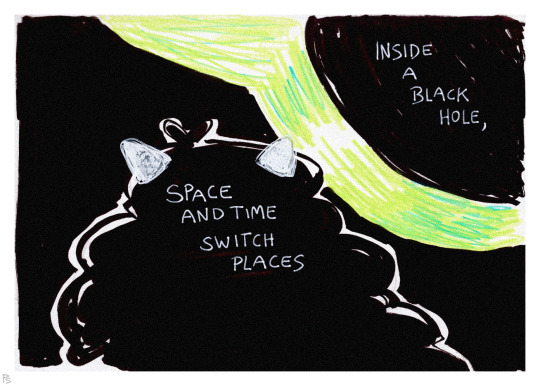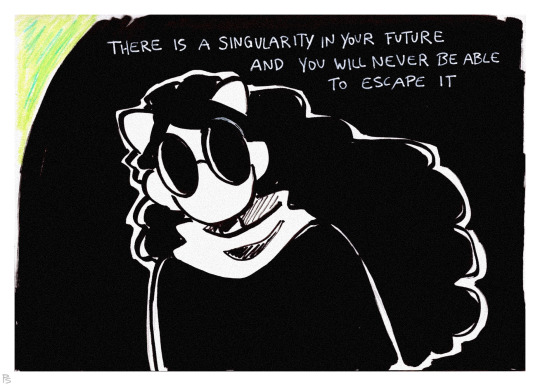Text
Left/right brain is a myth based on an outdated theory, the hemispheres of your brain do have differences but they don’t affect whether you’re analytical and intellectual vs creative and emotional
Rating: scientifically false
your brain is always developing and changing but it stops maturing around the 20s. So it’s not really true that it “fully develops” but it isn’t completely false either
Rating: misphrased
we only use 10% of our brains is just completely wrong. Why, evolutionarily, would we want to only use 10%?
Rating: scientifically false
y'all know that whole left-brained/right-brained thing is fake right? and the "brain fully develops at age 25" thing? and the "we only use 10% of our brains" thing? yeah they're all complete horseshit please yell at anyone who says them
#scientific accuracy#scientifically inaccurate#scientifically false#neuroscience#psychology#left brain#right brain
54K notes
·
View notes
Text
Claim #1: Inside a black hole, space and time switch places
This is mostly true, although a little over simplistic. It’d probably be more scientifically accurate to say “time becomes spacelike and space becomes timelike”
Rating: mostly scientifically true
Claim #2: There’s only one path forwards inside an black hole
Again, this is mostly true. There’s multiple paths per se, but all of them lead to the same place.
Rating: mostly scientifically true
Claim #3: There is an inescapable singularity in your future
This is true, and very well worded! This singularity is called the “BKL singularity” (named after 3 guys) and it’s called a strong spacelike singularity. Spacelike is kind of the opposite of what you’d think it would mean - it means that everything will inevitably hit the singularity. Once you cross the event horizon, the BKL singularity is in your future. Strong just means that the tidal forces (stretching and squeezing forces) become infinite at the singularity. All matter is destroyed and warped beyond recognition.
Rating: scientifically true
Overall Rating: Scientifically Accurate




about black holes
#tumblr posts#black holes#scientific accuracy#scientifically true#mostly scientifically true#scientifically accurate
981 notes
·
View notes
Photo
Throckmorton’s sign does exist and a positive Throckmorton’s sign is when someone’s dick is pointing towards the area of injury. However, studies have found that the sign is no more accurate in determining the location of injury than chance.
Rating: scientifically mixed

Throckmorton
592K notes
·
View notes
Photo
A purple-eye mutation that causes you to not have periods doesn’t exist.
Rating: scientifically false

“Alexandria’s Genesis, a.k.a violet eyes (a genetic mutation).
When someone is born with Alexandria’s Genesis, their eyes are blue or gray at birth. After six months, the eyes begin to change from their original color to purple, and this process lasts six months. During puberty, the color deepens to dark purple, a deep purple, a royal purple, or a violet-blue color and remains that way. It does not affect the person’s eyesight. Those who have this mutation will never grow any facial, body, pubic, or anal hair (not including hair on their head, on their ears, noses, eyebrows and eyelashes). Women also do not menstruate, but are fertile”
503K notes
·
View notes
Note
how accurate is The Clockwork Rocket by Greg Egan
Anon sorry for taking so long to answer your ask.
Time and Space - How Are They Related?
The book takes place in an alternate universe, where the laws of physics are slightly different. In our universe, velocity and time are inversely related - going very fast causes you to experience less time than a stationary observer. In the book’s universe, velocity and time are directly related - going very fast causes you to experience more time than a stationary observer. This effect is called time dilation and is predicted by Einstein’s special theory of relativity.
This universe also doesn’t have a universal speed of light. Instead of using our laws of relativity to determine how much time will pass for a stationary observer (which involves a complicated equation with a fraction under a square root) you can just use the Pythagorean theorem. One of the sides represents the distance traveled, one represents the amount of time experienced by an observer, and the hypotenuse represents the amount of time experienced by the traveler.
We aren’t sure at the moment if other universes exist or if they even could exist. If they do exist, they could have different laws of physics than the ones in our universe. Article about this
Rating: speculation
If we follow along with this ruleset, time and space have drastic changes. You now experience much more time compared to an observer if you were going very fast (rather than less as it is in our universe). You would also see weird other changes, like a colorful trail of rainbow light from the stars in the sky and a noticeable absence of black holes. This follows the ruleset of the story, but since it is still so foreign to what we know I can’t really justify a rating of scientifically true or scientifically plausible.
Rating: Scientifically possible
The author’s website is a great tool if you want to get deeper into the topic and learn more as well! He can explain it much better than me :)
#the clockwork rocket#Greg egan#orthogonal#orthogonal series#books#scientifically plausible#speculation#speculatively accurate
0 notes
Text
the lyric “black hole opened in the kitchen / every clock’s a different time” in Not Strong Enough by Boygenius is scientifically accurate! It’s a reference to gravitational time dilation caused by massive objects such as black holes.
#scientific accuracy#boygenius#not strong enough#black holes#time dilation#gravitational time dilation#scientifically accurate#scientifically true
4 notes
·
View notes
Text
The lyric “you slow down time” in Golden Hour by JVKE is scientifically accurate because according to Einstein’s general theory of relativity, any object with mass causes time to pass more slowly for someone nearby relative to a faraway observer
0 notes
Text
Want to make your RPG scientifically accurate? Wonder how true-to-science your favorite sci fi book or movie really is? Just want to know if that Tumblr thought experiment could happen irl?
You’ve come to the right place!
Tag this blog or send asks to find out if something is scientifically accurate or not. Anon asks are on, if you’d prefer. Then, I’ll do the math and research to find out if it’s scientifically accurate or not! Sources will be cited on my posts :)
My greatest area of knowledge is physics and astronomy, but questions about any area of science are welcome and I will try my best to answer them. That being said, if you have a lot of knowledge in the field of biology, chemistry, biochemistry, or psychology/neuroscience and want to co-run this blog, shoot me a DM.
Main account: @augmentedchordsofficial
Tags directory:
#scientifically accurate: a catchall tag for anything scientifically true, plausible, or possible.
#scientifically inaccurate: a catchall tag for anything scientifically impossible or false.
#speculation: a tag for anything that isn’t explicitly prohibited by science, but are so far out there that they aren’t really rooted in real science either. Examples include backwards time travel and human teleportation.
#scientifically true: a tag for things that we are sure are true and have been empirically tested. Examples include the existence of DNA and the planets orbiting the sun.
#scientifically plausible: a tag for things that we aren’t sure are true, but seem promising from leading theories. Examples include false vacuum decay and life developing on Earth from a meteor hitting it.
#scientifically possible: a tag for things that could be true, and are based in real science, but aren’t likely. Examples include wormholes and white holes.
#scientifically impossible: a tag for things that we know to be false based on our current, empirically-tested theories, even if we haven’t been able to test those specific aspects yet. Examples include FTL travel and escaping from a black hole.
#scientifically false: things that we have observed to be false. Examples include vaccines causing autism and the four elements being earth, water, fire, and air.
Warning: I am not a scientist. I will try my best to find you information, but if I can’t I may have to refer you elsewhere! I don’t anticipate this happening very often, but just wanted to give a heads up.
The quote in my header image is from the amazing scientifically-accurate book The Martian by Andy Weir. My blog description is a quote from the movie adaptation of said book.
My pfp is an image of the black hole from the awesome scientifically-accurate movie Interstellar (courtesy of DNEG studios, the visual effects studio for the movie).
2 notes
·
View notes